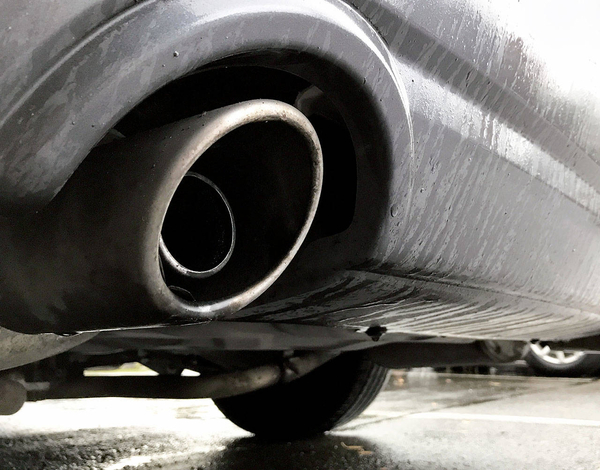 Mandatory emissions tests are supposed to be critical to the fight against air pollution. In reality, they are little more than a revenue scheme. |
THOSE WHO believe government is responsible for solving every problem frequently believe as well that the ideal solution is one that irritates the maximum number of people.
To prevent undocumented immigrants from getting jobs, they require every employee to supply proof of citizenship and every employer to process the paperwork — even though the vast majority of US workers are US citizens. To find drunk drivers, they set up roadblocks that force every driver to stop and be hassled — even though nearly all drivers are sober. To prevent felons from acquiring guns, they impose waiting periods and background checks on every gun buyer — even though all but a tiny fraction of them have clean records and lawful intentions.
Everyone is presumed guilty until he proves himself innocent — that is the Big Brother mindset.
Which brings us to automobile emissions tests.
If you enjoy wasting time and money while accomplishing next to nothing, you must relish getting a new inspection sticker each year. You find a service station that does emissions tests, you pay the fee, a guy sticks a probe up your tailpipe, and a new sticker goes on your window. Only a small minority of cars fail inspection, because only a small minority of cars pollute. But this is how government controllers operate: Every vehicle owner must be burdened so that a handful of dirty cars can be identified.
Now that burden is to be increased.
Washington is forcing 23 states to adopt "enhanced" tailpipe emissions tests that will prove even more annoying, expensive, and time-consuming than the current ones. In some states, the enhanced tests are already in effect — Maryland began requiring them last fall, California in June, and Georgia in July. Massachusetts is scheduled to impose the new tests next May; Rhode Island begins in January 2000. They are unpopular almost everywhere, and are being implemented by state legislatures only under the threat of federal sanctions.
The heart of the new test is a dynamometer, a treadmill-like device that simulates driving and enables auto exhaust to be checked even more precisely for pollutants. Dynamometers cost around $50,000 each, more than most garages can afford to spend. As a result, far fewer stations can perform the new tests, and those that do charge a lot more. In Massachusetts, the number of garages where motorists will be able to get inspection stickers is likely to drop from 2,200 to 1,200. The fee will jump from $15 to $30, if not more.
So: Tens of millions of car owners nationwide will be driving farther to get their car inspected, spending more time undergoing the test, and paying more for the privilege. Why?
Auto emissions tests are supposed to be critical in the fight against air pollution. In reality, they are little more than a revenue scheme for the state and a lucrative perk for service stations.
For the clean little secret of automobile exhaust is that it isn't very dirty. Since the Clean Air Act was passed in 1970, tailpipe emissions of carbon monoxide and hycrocarbons have dropped by a stunning 98 percent. Most cars don't pollute. Annual inspections catch so few cars violating emissions standards because there are so few to catch: As much as 70 percent of automobile-generated air pollution comes from 10 percent of the cars. According to Mobile Source Report, a newsletter covering auto emissions regulation and technology, California service station owners are already complaining that even with the tough new tests, only 2 to 3 percent of the fleet doesn't pass.
Drivers are being milked. They are forking over billions of dollars to be told, in most cases, that their cars are just fine. Those billions are not promoting pure air or cleansing the environment. They are merely enriching state treasuries and providing income to garages. If emissions tests weren't required by law, they would be shut down for fraud.
Mandatory tailpipe inspections would be bad enough even if there weren't a better way to catch polluting vehicles. But there is.
At the University of Denver, research chemists Donald Stedman and Gary Bishop long ago perfected remote-sensing technology that makes it possible to check emissions from cars driving along a highway. In a nutshell: Cars moving past a sensor are scanned by an infrared beam that instantly calculates the amount of pollution they are generating. Those not in compliance with the law are pulled over, and the driver is given 30 days to have the car repaired and retested. Cars that are clean — far and away the majority — never even have to slow down.
The arguments in favor of remote sensing are overwhelming. It's fast. It's accurate. It's cheater-proof. It's more than 100 times as efficient as the current system. (A service station, working very fast, can test eight cars per hour. On-road remote sensing can test 1,000 cars in that same hour.) It's also far better for air quality. Under the existing system, a car is free to spew pollution year-round — only when the owner brings it in for testing is he required to get it fixed. With remote testing, that car will be stopped the first time it passes by a sensor.
Indeed, there is only one argument against on-road testing. It leaves most people alone. Which is why goats will fly before the existing system is abandoned. And why you'll keep paying, year after year, for inspections stickers you don't need.
(Jeff Jacoby is a columnist for The Boston Globe).
-- ## --
Follow Jeff Jacoby on Twitter.
Discuss his columns on Facebook.
Want to read more? Sign up for "Arguable," Jeff Jacoby's free weekly email newsletter.

